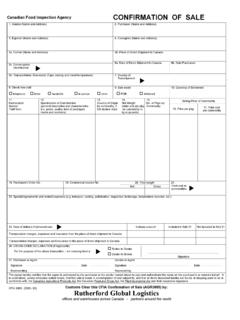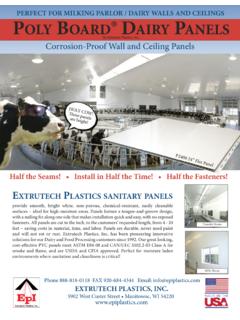Transcription of paper - Food and Agriculture Organization
1 Issues and options in developing and transition countriespaperISSN 0254-6019169 FAO ANIMAL PRODUCTION AND HEALTHGOOD PRACTICES FOR BIOSECURITY INTHE PIG SECTORC over photographs:Left: FAO/Pius Utomi Ekpei Center: VIKTAR STRALKOUSKI - Right: FAO/J. AnnelliFAO ANIMAL PRODUCTION AND HEALTH169paperGOOD PRACTICES FOR BIOSECURITY INTHE PIG SECTORTHE FOOD AND Agriculture Organization OF THE UNITED NATIONSTHE WORLD ORGANISATION FOR ANIMAL HEALTHTHE WORLD BANKRome, 2010 Issues and options in developing and transition countriesRecommended citationFood and Agriculture Organization of the United Nations/World Organisation for Animal Health/World Bank.
2 2010. Good practices for biosecurity in the pig sector Issues and options in developing and transition countries. FAO Animal Production and Health paper No. 169. Rome, designations employed and the presentation of material in this publication do not imply the expression of any opinion whatsoever on the part of the Food and Agriculture Organization of the United Nations (FAO), or of the World Organisation for Animal Health (OIE) or of the International Bank for Reconstruction and development/The World Bank concerning the legal status of any country, territory, city or area or of its authorities, or concerning the delimitation of its frontiers or boundaries.
3 The mention of specific compa-nies or products of manufacturers, whether or not these have been patented, does not imply that these have been endorsed or recommended by FAO, OIE or The World Bank in preference to others of a similar nature that are not mentioned. The views expressed herein are those of the authors and do not necessarily represent those of FAO, OIE or the Executive Directors of The World ISBN 978-92-5-106507-5 OIE ISBN 978-92-9044-809-9 All rights reserved. FAO and OIE encourage the reproduction and dissemination of material in this information product. Non-commercial uses will be authorized free of charge upon request.
4 Reproduction for resale or other commercial purposes, including educational purposes, may incur fees. Applications for permission to reproduce or disseminate FAO copyright materials and all other queries on rights and licences, should be addressed by e-mail to or to the Chief, Publishing Policy and Support Branch, Office of Knowledge Exchange, Research and Extension, FAO, Viale delle Terme di Caracalla, 00153 Rome, Italy. FAO and OIE, 2010 iiiContentsAcknowledgements vAcronyms and abbreviations viExecutive summary viiIntroduction 1 Background and rationale 1 Target audience 2 SECTION 1 Defining biosecurity 3 Basic principles of biosecurity at the farm level 3 SECTION 2 Swine diseases.
5 Routes of transmission and implicationsfor biosecurity 5 Main diseases affecting swine 5 Infectious diseases with transboundary implications 5 Other severe infectious diseases 5 Endemic production diseases 6 Zoonoses 6 Routes of disease transmission and implications for biosecurity 7 Direct pig-to-pig contact 7 Semen 7 Airborne transmission 7 People 7 Vehicles and other fomites 8 Pig feed, including swill feeding, and drinking-water 8 Pig manure and bedding 8 Birds, bats, rodents, feral and wild pigs and stray/domestic animals 9 Arthropods 10 SECTION 3 Structure of pig production and marketing chains 11 Pig production systems 11 Scavenging pigs 11 Small-scale confined pig production 12 Large-scale confined pig production 13 Large-scale outdoor pig production 15ivService providers, suppliers and marketing chains 15 Artificial insemination centres and boar keepers 15 Service providers 16 Marketing chains.
6 Live-animal markets and slaughterhouses 16 SECTION 4 Biosecurity issues and good practices in the pig sector 17On-farm risks and related biosecurity measures 17 Scavenging pig production 17 Small-scale confined pig production 20 Large-scale confined pig production 25 Large-scale outdoor pig production 30 Biosecurity measures for service providers and along marketing chains 32 Artificial insemination centres and boar keepers 32 Brokers and transporters 32 Slaughterhouses 33 Live-animal markets and exhibitions 34 Challenges in the implementation of biosecurity measures 34 Social and economic factors 34 Sharing of responsibilities between the private and public sectors 35 Animal health systems and veterinary services 35 Education and extension services 36 The role and importance of communication in promoting biosecurity 36 The traffic light system 37 Complementary tools.
7 Vaccination, traceability, compartmentalization 38 Vaccination programmes 38 Premises definition and animal identification 38 Compartmentalization 39 Conclusion 41 Annexes1. Characteristics of selected biosecurity measures 452. Potential for uptake of selected biosecurity measures 473. An overview of disinfection procedures 494. OFFLU strategy document for surveillance and monitoring of influenzas in animals 515.
8 Glossary of definitions 576. Reports 637. Manuals 658. Selected articles 679. Selected websites 73vAcknowledgementsThis report was written on behalf of the Food and Agriculture Organization of the United Nations (FAO), the World Organisation for Animal Health (OIE) and the World Bank, under the overall guidance and responsibility of Dr J. Domenech and his successor Dr J. Lubroth, Chief Veterinary Officers of writers were Fran ois Madec, Deputy Director of the French Agency for Food Safety (AFSSA), Veterinary Research Laboratory, Ploufragan (France); Daniel Hurnik, University of Prince Edward Island (Canada); and Vincent Porphyre and Eric Cardinale, veterinarians and researchers in animal husbandry and epidemiology at the International Cooperation Centre of Agricultural Research for Development (CIRAD).
9 The report was reviewed by a multidisciplinary team from FAO (Philippe Ankers, Nicoline de Haan, Klaas Dietze, Vittorio Guberti, Nick Honhold, Anthony Burnett and Juan Lubroth), OIE (Alain Dehove, Kathleen Glynn, Kazuaki Miyagishima and Alex Thiermann) and the World Bank (Jean Kamanzi, Brian Bedard, Nancy Morgan, Stephane Forman and Jimmy Smith), together with international experts (Sandra Amass of Purdue University, United States; Jordi Casal F brega of Centre de Recerca en Sanitat Animal [CReSA], Barcelona, Spain; Scott Dee of the University of Minnesota, United States; Dominiek Maes of Ghent University, Belgium; and Keith Campbell and Jane MacDonald of the Canadian Food Inspection Agency [CFIA]).
10 Grateful appreciation is extended to all of these of this document was made possible by financial support from FAO and the World and abbreviationsAFSSA French Agency for Food SafetyAI artificial inseminationASF African swine feverCDC Centers for Disease Control and Prevention CFIA Canadian Food Inspection AgencyCIRAD International Cooperation Centre of Agricultural Research for DevelopmentCSF classical swine fever (hog cholera)EU European UnionFAO Food and Agriculture Organization of the United NationsFMD foot-and-mouth diseaseHPAI highly pathogenic avian influenzaJE Japanese B encephalitis MRSA Methicillin-resistant Staphylococcus aureusNGO non-governmental organizationOFFLU OIE-FAO Network of Expertise on Animal InfluenzaOIE World Organisation for Animal Health PRRS porcine reproductive and respiratory syndromeSPF specific pathogen-freeTAD transboundary animal diseaseTGE transmissible
















